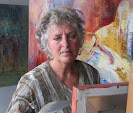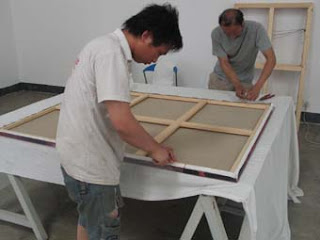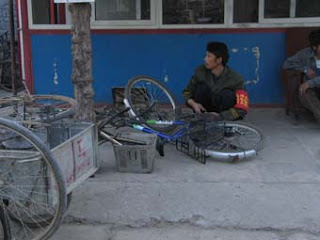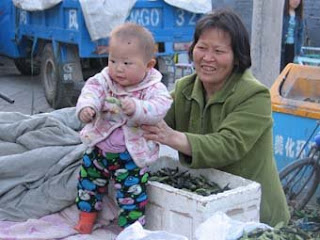A last reflection to end this weblog after 30 days of my “Beijing Project”. It has been a marvellous experience. I had a measuring point because of our visit to Beijing and China 13 years ago but then as normal tourists. I now know that I just have to forget that after a stay of one month as a less normal tourist in a small quarter of the city that has in it a lot of aspects of the city as a whole and where I could make contact with several layers of the population.
The Beijing of today cannot be compared to the old one. Of course I have to be careful with extrapolating Beijing to the rest of China. As you cannot say that you have visited de US after a visit to New York, you also cannot say that you visited China after a visit to Beijing. But nevertheless it’s no problem to conclude that China is changing enormously. A couple of days ago I wrote that reading about this is just one thing but really experiencing it is something quite different.
A city with 6 rings of 6 lanes around the centre with the 6th ring having a radius of more than 25 kilometres, a city with a lot of new nuclei of which every one in itself is big enough to be a city in The Netherlands, a city with everywhere new, sky high apartment buildings in a often very nice variety of architectural styles, a city with an enormous amount of new and also nice office buildings. You cannot show that by pictures, you only get the feeling by driving through it.
And also a city with a bubbling art scene. A city where thousands and thousands of artists are trying to earn some money and becoming famous, a city with an endless amount of art galleries with often huge exhibition spaces. You should say that such a development cannot go on, also because in the modern art world India is coming up now like China did before. But may be I do not judge this in the right way if you have a look at the Law of the Big Numbers. If in the future only 1% of the Chinese are getting interested in art and are willing to spend money for it, their number is nearly the population of The Netherlands.
All over Beijing you notice that the model of Western consumption is becoming popular. Very big shops for electronics, shopping malls in American style, an amount of expensive new cars, enough to cause a total stoppage in every city in my country, in spite of the many kilometres of subway lines that have been build in an unbelievable short time and that are used by many, many people who cross Beijing for just 20 eurocents and, well, just name it!
All the disadvantages of this, the traffic jams, the air pollution, the breaking down of the old Beijing, seem to be accepted more or less by most of the people. But they have seen worse things during the last half century. As far as it’s possible for me to judge it in the right way after meeting with and talking to a lot of people I think that they are quite satisfied with the situation of the moment. I found them much more open and laughing more easily than 13 years ago. The many artists I met showed all a great hospitality in spite of the fact that they knew I was just a ‘poor’ artist from The Netherlands who didn’t come to buy their work. The people in the hutong nearby were all very friendly and curious and all clothed clean and proper in a Western way. ‘Our’ driver, who drove a lot of kilometres with us in his car, dreams of a big house near the water with his wife and kid. I got the feeling that people ‘live’ much more than 13 years ago and also have the possibility to ‘live’.
Is this an ode to Beijing? No, certainly not! But I’m asking myself now carefully if we in the West have the right image of this country and don’t emphasis too much only the negative aspects that of course are also present.
The Beijing Project of Toos van Holstein
The Beijing Project
During the month of May I, Toos van Holstein, am artist in residence in the NY Arts Gallery Beijing in China. In this time I want to create in one of the big spaces of the gallery an exhibition of oil paintings of my hand. But as a part of the exhibition I also want to cooperate with several Chinese artists in creating a symbiosis between the Chinese modern art and the Western modern art. For this I have available 8 banners of 6 meter length on which already parts of paintings of mine have been printed. On these banners I want to work with the other artists in changing them in new art works that will hang down from the high ceiling in the gallery space.
About me
donderdag 29 mei 2008


When there is an opening, there is also a closing. Today, to my regret, the closing of my exhibition here in Beijing had to be effectuated. ‘To my regret’ because for my feelings this month has been much too short and I wouldn’t mind to stay here a bit longer.
The same men who hanged my banners in the beginning came to bring them down. As usual taking down is done much quicker than building up. It was clear they had been thinking about the best way to remove the clamps that fixed the banners to the beams of the roof with a scaffolding as low as possible. A long stick showed to be the best solution (see the photo’s).
They also helped removing the staples with which my oil paintings were pinned to the wooden frames, rolling up the banners with the paintings around them and packaging all for the transport back home.
Suddenly the big exhibition space that had housed my work for the last couple of weeks seemed very empty. But all thing come to an end, also this Beijing art adventure that has been very inspirational. Tomorrow I’ll write for the last time in this weblog of my “Beijing Project” and then also this part of the project can be closed because on Saturday morning we fly back to The Netherlands. But much of a rest is not foreseen then, on Sunday waits the so-called Art and Culture route in my hometown Middelburg that is always held on the first Sunday of the month.
woensdag 28 mei 2008


Just when you think that you have seen a lot of art, a lot of studios and have met a lot of interesting artists you bring a visit to SongZhuang and you get the feeling that you can start it all over again.
But may be it’s better to start this story with a right beginning. In The Netherlands we had already made e-mail contact with Nanfei Wang, a professional female artist in Beijing (see photos). A couple of days ago she came to view my exhibition and we made the appointment to visit her studio. When she told we had to go to SongZhuang for that a bell started to ring. Because when you know your way in the literature of modern art in Beijing you also know that this is the name of the first art village near Beijing. In 1995 some young artists from Beijing settled in this farmer village about 30 kilometres from the city. There they were driven out by the authorities to find shelter and studios in SongZhuang where they were left in peace. As often happens in places where artists find a place to work, just think about Soho in New York a long time ago, things start to happen. In combination with the less stricter politic system that was introduced somewhat later this new atmosphere in the village has lead now to a flourishing art community of about 1500 registered artist, not counting for the many unregistered ones.
Do not think it’s a cosy place, this SongZhuang, because there are no such places around Beijing. Just imagine clusters of houses and some bigger buildings intersected by farmland, small factories and roads, to far away from each other to walk. But the farmland is getting less and less because the farmers have discovered that they can earn more money by building complexes of artist studios and rent them. Because a new rule says it’s not possible anymore for non citizens to by property as was the case in the past. This place, so important in the history of modern Chinese art, we visited today.
Our guide Nanfei, who has struck root here in the community and speaks English very well, took her time to give us a tour in our cab with driver we had hired for the whole day. In this way we visited a lot of studios of art friends of hers, we had overwhelming welcomes everywhere, our lunch was secretly paid for by a friend of hers who sat on a table nearby, one of my visits was even filmed, my signature can now be found on a big canvas and saw of course a lot of galleries in old but renovated factories. The art itself showed again its variety in images and techniques, in authentic or stolen styles. But the last is here no problem at all.
This day went by too fast and we have only seen a very small part of what SongZhuang has to offer. But we saw again enough to conclude that the art in and around Beijing fizzes in an unbelievable way.


dinsdag 27 mei 2008


Mijn levensgezel zegt altijd “als je ’t groot maakt of veel blijkt het ineens kunst te zijn”. Zet bijvoorbeeld één lege melkfles in een grote, lege fabriekshal, dan heeft iemand die fles gewoon vergeten. Maar zet je er 5000 van die flessen neer, dan ineens is het een installatie en dus kunst, als je er ten minste nog een ingewikkeld verhaal bij vertelt over de veranderende lichtinval in de loop van de dag en de invloed die de flessen hebben op de lichtweerkaatsing, bla, bla, bla, enz.
Maak je een goed lijkend beeld van een naakte zittende baby op ware grootte, dan zal men zeggen ‘leuk’. Maar maak je het zes meter hoog en staat ’t op de Biënnale van Venetië, dan ineens is iedereen onder de indruk en is het echte kunst. Persoonlijk denk ik daarbij eerder aan het verhaal van Andersen over de kleren van de keizer, vooral gezien de naaktheid van de baby.
Deze truc werd in de Westerse moderne kunstwereld al veelvuldig toegepast, dus is ’t logisch dat we ‘m ook hier tegen komen. Het leek me wel interessant daarvan een paar uitingen te tonen. De melkfles is dan wel vervangen door een bepaald beeldje maar lekker vaak te herhalen, de baby is vervangen door een zeer vergrootte metalen cilinder van het type medicijncapsule zoals dat over de hele wereld wordt geslikt, iemand heeft een grote pannenzaak volledig leeg gekocht en weer een ander is lekker gaan kleien met héééél grote klonten klei om er andere grote klonten klei van te maken. Je kunt natuurlijk ook een paar bloederige wc-potten neerzetten met portretten van Tweede Wereldoorlog-figuren of een rotstuin installeren met grote stukken glinsterend blik, precies nagemaakt naar echte rotsblokken. De moderne kunstwereld in Peking is dus druk bezig met een installatie-inhaalslag. En ach, hier hebben ze ook keizers gehad! Logisch dus dat de Duitse kunstgoeroe Joseph Beuys aan Mao de moderne kunst moet uitleggen (laatste foto).






maandag 26 mei 2008


Being in Beijing now means you absolutely have to visit the tourist obligation number one, the OLYMPIC AREA, the place where IT all is going to happen in August. It doesn’t matter how you think about all the publicity the Olympic Games get in all its forms, a bit too much in my eyes but who am I, you cannot just pass it here. If it’s not the big displays everywhere with the seconds countdown till The Day or the huge posters of sponsors of the games, it’s the image of the five rings on all the beer bottles here and there are many beer bottles.
So yesterday, Sunday, had to be the day. We planned to have a quiet walk around, and may be over the area with the different stadiums. This was a wrong idea! What we didn’t know was that just this weekend for the first time athletic games were organised in the big stadium and that this was a great opportunity for many Chinese families to admire their own spaghetti building from the in and outside for a reasonable price. Because the price for an Olympic ticket is a bit outrageous for a normal Chinese income. So it was sold out which in itself should already have been a good reason for an extreme bustle but the parking facilities and the Olympic subway line are not yet ready. Result? Traffic chaos! But nevertheless we could have some walks along the fences that stretched away for many kilometres with also a lot of military guards.
A few kilometre north of the central stadium, the blue building for the swimming (see photo) and this spectacular skyscraper in the form of the Olympic flame another area is found with for instance the tennis (see photo) and the hockey stadiums embedded in a lot of green and parks.. Here it was remarkably quiet.
The conclusion is that costs didn’t play a role, cheap labour is still abundantly present and finding ground so near to the centre of the town has not been seen as a serious problem by the government. In this way a spectacular concentration of sports facilities has been build. But I couldn’t get the idea out of my head that the months of June and July form a very precious supply of time that is very much needed to complete the picture.





zondag 25 mei 2008

Sunday, day of the Lord! But the real reason that there is no instalment today of this weblog, lies in the fact that we just came home now, about 11pm, from a barbecue with some of our neighbours, the Georgian sculptor Aleksandre and his Chinese wife, tapestry weaver Nino in the company of Australian, Spanish/Brazilian and Korean people in which from time to time also Russian was spoken.
zaterdag 24 mei 2008

Saturday evening is clearly a free evening. That was not so difficult to notice in ‘our’ hutong because of the lively atmosphere. So we feel it really after several weeks, ‘our’hutong. If we walk around in the ‘shopping mall’ it’s a mutually reconnaissance, friendly smiles and a lot of waving hands. Therefore this hutong deserves tonight the attention with a lot of pictures and a short text.




Abonneren op:
Posts (Atom)





































